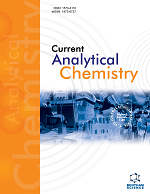-
oa Editorial [Mini Hot-Topic: Recent Advances of Liquid Chromatography and Mass Spectrometry (LC-MS) Analysis in the Omics Era (Guest Editor: Ming-Quan Guo)]
- Source: Current Analytical Chemistry, Volume 8, Issue 1, Jan 2012, p. 1 - 2
-
- 01 Jan 2012
Abstract
Soon after the word “proteome” was firstly coined by Marc Wilkins in 1994 to describe the sum of proteins produced by an organism or a biological system, the term “proteomics” was coined to define the large scale study of the proteome. Ever since then, especially after the completion of the draft sequence of the human genome, various “omics (or-omes)” terms have been created to signify the study of respective “–omes” at an amazing pace, which reflects a new omics era. Among a number of omics terms, genomics, transcriptomics, proteomics, metabolomics, and interactomics (large scale analysis of all the interactions among various biological components) have gained more and more popularity than others and are even reviving and boosting a very promising discipline of systems biology, which is the study of systems of biological components. Characterized by common features and analytical challenges from the point of view of current analytical chemistry, all these omics studies require highly sensitive and high throughput analysis of a very large number of components from a very complicated biological system. From another point of view of biological systems, proteomics, metabolomics and interactomics analysis is much more complicated than genomics and transcriptomics, because genome and transcriptome are more or less constant and are made of less number of “chemical units (DNA or RNA molecule)”, which has been reflected in the recent technological advances now allowing genomes or transcriptomes to be sequenced at a breathtaking speed by means of a large-scale, high throughput DNA sequencing platform or microarray technologies. It is well known that the completion of the draft sequence of the human genome was achieved over ten years ago, while the human proteome or metabolome are still far beyond the reach due to the inherent complexity, even with tremendous technological advances in the past ten years, let alone the much more complicated interactome. However, proteomics and metabolomics, which focus on a large-scale analysis of proteins and metabolites, are among the highly pursued goals in biomedical research. This mini Hot Topic Issue mainly addresses analytical challenges and the most recent advances in these two omics fields. Since proteomics and metabolomics analysis are highly dependent on a similar set of analytical tools, the most powerful liquid chromatography (LC) and mass spectrometry (MS) in the current analytical sciences. This special issue is thus aimed to provide state-of-the-art LC-MS based strategies for proteomics and metabolomics analysis, with an emphasis on its success in the biomedical or pharmaceutical applications. The technological advances in liquid chromatography coupled to mass spectrometry (LC-MS) have expended tremendously to the proteomics analysis with the discovery of electrospray ionization (ESI) method in the late 1980s by John Fenn which provided a highly compatible interface between LC and MS and was recognized by the award of the Nobel Prize for Chemistry in 2002. By combining the physical separation capability of LC with the universal mass analysis power of MS, LC-MS has become increasingly important in both proteomics and metabolomics due to its unparalleled capability in the mixture analysis with a high sensitivity and selectivity since then and continues to be the key and leading technology in omics with the continuously incremented developments in both LC separation and MS based detection. Nowadays, biomarker discovery, biomedical studies and biopharmaceutical industries rely heavily on the valuable information extracted from LC-MS based omics analysis. For current proteomics research, it has been shifted from conventional 2-D Gel and MS based analysis to various stable isotope labeled quantitative gel-free methods and more recently to gel-free and label-free LC-MS based strategies. Meanwhile, more and more interests in the proteomics analysis have changed its theme from global qualitative identification of proteins as many as possible to quantitative analysis of targeted protein post-translational modifications (PTMs), such as protein phosphorylation and glycosylation. To reflect these updated trends in proteomics, this issue has put more weight on both LC-MS based quantitative proteomics and phosphoproteomics which is a large-scale study of phosphorylated proteins, representing one of the most important protein post-translational modifications. As for metabolomics research, because it is a much more complicated analysis as compared to that of proteomics, up to now, the metabolomics research advance is so far behind proteomics. This issue also covers the most recent LC-MS based metabolomics progress in Panax ginseng research, which has implied the powerfulness and great promise in the application of MS-based metabolomics strategies to reveal the chemical components and pharmacological activity of ginseng in this special field. This mini- Hot Topic Issue will include four chapters (topics). A brief introduction to each Chapter (topic) will be illustrated as below. Phosphoproteomics is the large-scale study of protein phosphorylation, which is one of the most important protein PTMs and plays a central role in regulating a wide array of cellular signaling pathways from prokaryotes to eukaryotes. Quantitative phosphoproteomics is a rapidly growing, while challenging subject in proteomics research expanding our understanding of biology and diseases, because it has exhibited great promise for the discovery of new drug targets and biomarkers. Chapter 1, reviews the most recent developments in LC-MS based phosphoproteomics with an emphasis on quantitative phosphoproteomics and details the most up-to-date popular strategies in quantitative phosphoproteomics and the advantages and limitations of each method. This intensified review will not only serve as a quick guideline for mass spectrometrists who strive to develop tailored quantitative phosphoproteomics strategies for various research subjects, but also an informative introduction to scientists in related field, like biologists who may have a lot of interest in this very promising topic in proteomics....


